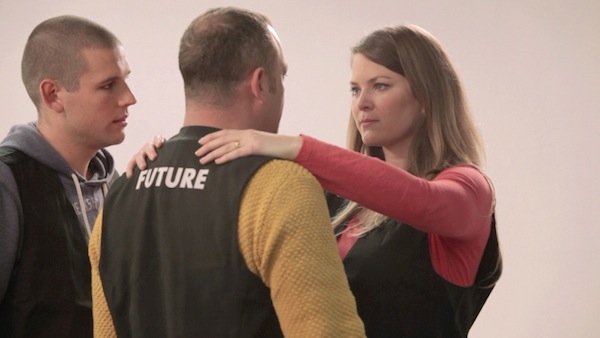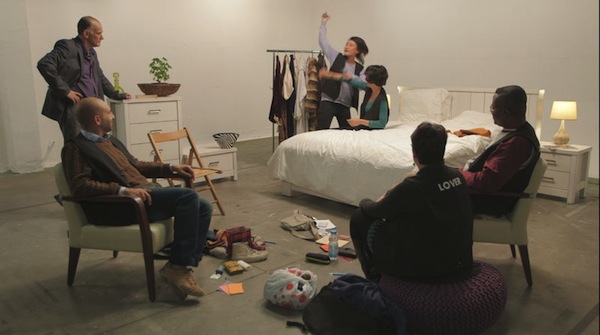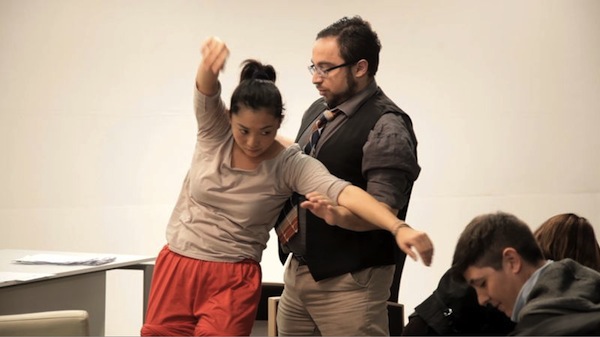Guest Post: A Different Kind of Happiness Than My Mother’s

Einat Amir, Our Best Intentions, 2013, still from a video installation
Ophra immigrated to Israel from the US 3 years ago.
She is a graduate of the University of Maryland and an M.A. candidate at the Art History Department of the University of Haifa.
She is currently writing her thesis on contemporary Israeli photography and working at Gordon Gallery, Tel Aviv.
Exhibition: Our Best Intentions
Artist: Einat Amir
Venue: Petach Tikva Museum of Art
Dates: Until January 4th, 2014
Nearly a year ago, the video artist Einat Amir came to the University of Haifa, where I was studying Art History, to give a talk about her work. I was already familiar with some of her videos and after hearing Einat speak I had a good grasp of her general interest in stretching the lines between art, anthropology and psychology. When she finished her lecture she asked the audience if they knew English speakers (without an Israeli accent) who would be interested in participating in her next video, Our Best Intentions. I signed up.
The first stage was an intake film. I went to Artport where Einat was doing a one-year residency and sat down in a chair facing a video camera. I signed away my rights. Einat and her assistant Renana started to ask me questions about myself. They started out innocuously and then delved deep. Of course, I only had to answer if I wanted to.
“Have you ever been in love? How many times?”
“How is your relationship with your parents?”
As an extrovert, I am usually ready to share with whoever asks but when the camera was in front of me I began to weigh my words with more care than I ever had before.
“I have been in love one and a half times.”
I waited to hear if I was to be selected from all the candidates for the final project and was quite pleased when I received instructions for the next step. I traveled from Haifa to Tel Aviv and arrived in time for a casual lunch of French fries and mini burgers. There were four other participants from my group present as well as those from the group that had been filmed that morning. I began socializing with my fellow guinea pigs: an airline steward from northern Europe, a Phd in Yiddish, a foreign worker from India and an MFA from the University of Haifa who I already knew (albeit, not very well).
We were instructed to choose a black vest with words written on the back. I chose “friend.” The space where we were filming was set up like a home office. The filming took about 5 hours. A dancer/choreographer named Mami led our group. She has been dancing for many years with the Bat Sheva Dance Company in Israel; she speaks very good Hebrew and perfect English but she is Japanese. The lights were hot and there were many people working the cameras. We were instructed to perform certain movements as Mami called out specific words: mother, lover, career, family, etc. We were then asked to make up movements for the words on our vests and took turns guiding the group as Mami had. To conclude our session, we wrote sentences that contained some of the words and read them to the group while they acted out the movements for the words.
“I am trying to find a different kind of happiness than my mother’s.”

Einat Amir, Our Best Intentions, 2013, still from a video installation
The technicians, participants and Mami were all people I am unlikely to ever meet in my day-to-day life and even more unlikely to have an intimate therapeutic experience with. The experience not only gave me the chance as an academic to participate in the expression of a work of art, but it also was a unique opportunity to understand the mind and soul of individuals living vastly different lives then me.

Einat Amir, Our Best Intentions, 2013, still from a video installation
The final video comprises four groups; each with five participants, a leader, black vests with words on the back and sharing. The room in the museum is staged in four sections, each like a room in a house, the furniture matching that of each projected video. They were shockingly personal. They were very touchingly raw. They were therapy sessions opened to the public. In the world we live in, psychotherapy is a private thing but public sharing (and over-sharing) happens on reality shows all the time. The hype and hysteria of reality shows warp our understanding of the experiences of others and discourage empathy. Einat, flips the coin with Our Best Intentions, she not only invites you to view four authentic group therapy sessions, but she also offers the viewers a chance to participate in a series of interactive performances scheduled at each location on the exhibition’s world tour.

Einat Amir, Our Best Intentions, 2013, still from a video installation
Going into the filming I had no idea what to expect or what I would share. I am pleased with the result. I was honest and I think that many people will find comfort in knowing they are not alone in feeling what I and the other participants in theses films shared that they feel.
“I like pursuing my career, I am afraid I cannot have it with a lover and a family.”
Curious to know what you would share? Sign up for one of Einat’s workshops and find out.